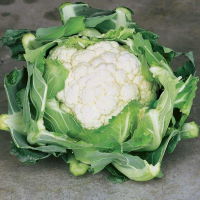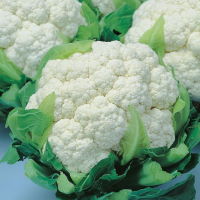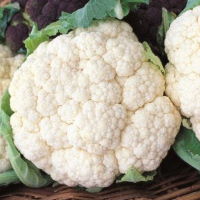Cauliflower - Summer
Type: Vegetable
Rotation Group: 4, Brassicas
 | | ALL THE YEAR ROUNDAll The Year Round is a good old standby variety as it is highly reliable. The quality of this vegetable truely is the mark of a good gardener with large curds surrounded by dark green leaves. Sow October in a cold frame, plant out in March, cut in June. Sow February to April, cut late June to September. |
 | | CLAPTONClub root a problem? Not with Clapton F1, which is resistant. This late summer cropper gives heavy, dense, very white heads of superb quality and flavour. A real breakthrough. |
 | | SNOW CROWNAn outstanding summer/autumn cauliflower, the vigorous plants are early to produce smooth, white heads up to 1.2kg. The large leaves give the curds plenty of protection. |
 | | SNOWBALL"Snowball Cauliflower is a highly suitable variety for the home garden. It is a regular favourite that has stood the test of time. It produces dwarf compact plants which can be set closer than others.
" |
Site, Soil and Preparation
Cauliflowers need very fertile soil to produce the best. Dig in plenty of well-rotted manure or organic matter before planting. Raking in a high potassium general fertiliser at a rate of three handfuls per square metre/yard, will help growth. Firm the soil well before planting.
Indoor Sowing
To obtain best results sow cauliflower seeds in a cold greenhouse in cell trays (2 or 3 per cell) using any good multi-purpose potting compost.
Outdoor Sowing
Sow thinly, 20mm (3/4in) deep in a seedbed. Final rows should be 150mm (6in) apart for mini cauliflowers or around 600mm (24in) for larger varieties.
Thinning
When indoor sowings have produced 2 main leaves thin to 1 seedling per cell.
Thin outdoor seedlings to a final spacing of 150mm (6in) apart for mini cauliflowers or 600mm (24in) for larger varieties.
Transplanting
Summer cropping types should be spaced 600mm (2ft) apart. Mini cauliflowers should be spaced 300-450mm (12-18in) apart.
Care
Water once a week in dry weather. Water well, applying sufficient water to thoroughly wet the roots. Once the plants are growing well, add 30g (1oz) per square metre of high nitrogen fertiliser such as sulphate of ammonia to boost growth and curd formation.
Harvest
The head should be firm and compact. As soon as it starts to separate it will be past its best and will taste bitter. White varieties should be harvested before they turn yellow. Cut the stem with a knife, taking the head and a few of the leaves below.





